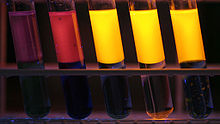
Back Nile blue Danish Nilblau German Niilinsininen Finnish Nilsko plava Croatian Níluskék Hungarian ナイルブルー Japanese Nilsko plavo Serbo-Croatian Nilsko plavo Serbian

| |

| |
| Names | |
|---|---|
| IUPAC name
[9-(diethylamino)benzo[a]phenoxazin-5-ylidene]azanium sulfate
| |
| Other names
Nile blue A, Nile blue sulfate
| |
| Identifiers | |
3D model (JSmol)
|
|
| ChEMBL |
|
| ChemSpider |
|
| ECHA InfoCard | 100.020.757 |
PubChem CID
|
|
| UNII | |
| |
| |
| Properties | |
| C20H20ClN3O | |
| Molar mass | 353.845 g/mol |
Except where otherwise noted, data are given for materials in their standard state (at 25 °C [77 °F], 100 kPa).
| |
Nile blue (or Nile blue A) is a stain used in biology and histology. It may be used with live or fixed cells, and imparts a blue colour to cell nuclei.
It may also be used in conjunction with fluorescence microscopy to stain for the presence of polyhydroxybutyrate granules in prokaryotic or eukaryotic cells. Boiling a solution of Nile blue with sulfuric acid produces Nile red (Nile blue oxazone).

Concentrations, left to right: 1000 ppm, 100 ppm, 10 ppm, 1 ppm, 100 ppb.

Left to right: pH 0, pH 4, pH 7, pH 10, pH 14.

Left to right: pH 0, pH 4, pH 7, pH 10, pH 14

Left to right: pH 0, pH 4, pH 7, pH 10, pH 14

Left to right: 1. methanol, 2. ethanol, 3. methyl-tert-butylether, 4. cyclohexane, 5. n-hexane, 6. acetone, 7. tetrahydrofuran, 8. ethyl acetate, 9. dimethyl formamide, 10. acetonitrile, 11. toluene, 12. chloroform
© MMXXIII Rich X Search. We shall prevail. All rights reserved. Rich X Search